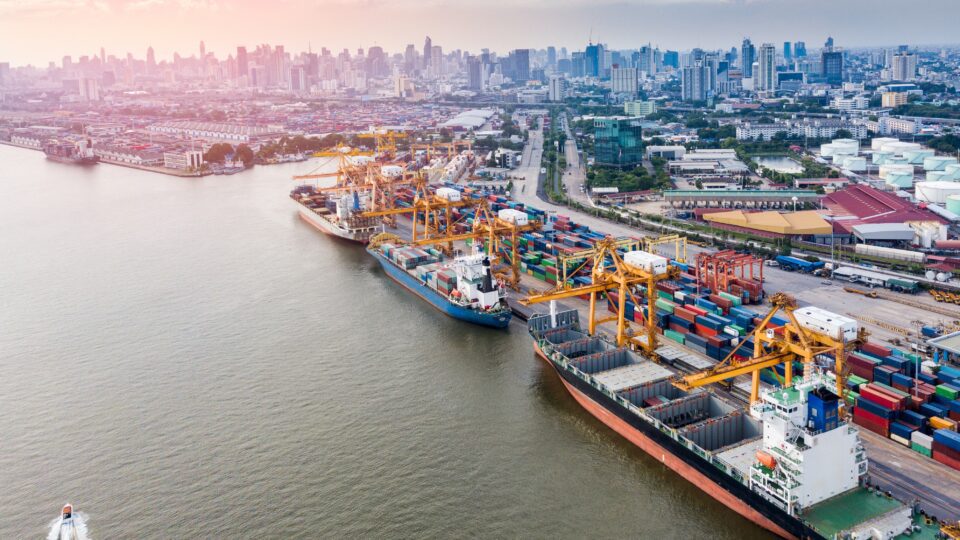As President Trumps’s tariffs continue to bounce around, country by country, much of the focus has been on the percentage of the day: 30%? 50%? 145%?! But even when the rates finally settle, the costs associated with those still amorphous percentages go deeper — in large part because of the unpredictability that has characterized their implementation.
The push and pull of forceful announcements followed by pauses and delayed timelines has created a compounding cost burden that’s being felt across the U.S. supply chain — from freight and warehousing fees to labor and packaging.

As CEO of logistics provider G10 Fulfillment, Mark Becker has a seat right at the center of the turmoil. Retail TouchPoints sat down with the 20-year supply chain veteran to hear firsthand about the situation on the ground and get advice on how companies can handle the ongoing uncertainty.
Retail TouchPoints: As a 3PL provider, you’re right in the middle of all this tariff confusion. What has the experience been like on your end?
Mark Becker: It’s been really volatile. In May, for a lot of the small- and medium-sized brands that we work with — mainly direct-to-consumer brands — the 145% tariff was a game-changer, almost to the point where they couldn’t order any product. They were putting everything on hold and just waiting and hoping the tariffs went down.
That creates a ripple effect — containers aren’t coming over the ocean, our warehouses aren’t receiving any product, and then all of a sudden the tariffs go down, and now there’s a flood of product — to the point that a lot of our manufacturers are over-buying now as a kind of defensive move against the tariffs. They’re saying, “Okay, they’re down at 35%. Let’s get as much product over as we can now because we’re still uncertain of what will happen in the next 60 to 90 days.”
That just creates chaos. It creates a lot of manual work, and it also creates a lot of fraud. So one of the things we have to navigate, and it was really bad right at the beginning, is that a lot of the manufacturers are quickly trying to change a label to say it’s coming from a different country, doing things to try to find the loopholes, because they don’t want to pay the tariff, but they don’t want to lose the business. So on our side, that was a real pain point.
I work directly with over 20 Chinese factories, and with every single one of them we were having conversations and trying to understand what they needed to change their pricing to, and then how that impacted the retailers in the U.S.
Some of them were requesting things like bonded warehouses [a customs-controlled warehouse where goods are held until duties are paid], and we have a couple of those, but not all of our warehouses are bonded. There’s an expense to creating a bonded warehouse, and if the tariffs are just going to go back down, do we really want to go through the process of making all our warehouses bonded? So it was a lot of questions with not a lot of answers, and I feel like a lot of us just played the wait-and-see game. And then during that, the prices of containers went from $3,500 from Asia to the West Coast to almost $7,000 a container, so that pricing has gone up.
The tariffs are impacting everyone’s margins, and no one was able to move fast enough to change their inventory levels or become smarter in the moment. Now everyone’s trying to do that. Now, everyone’s saying, “Alright, given this new environment, what should my inventory levels be in the U.S.? And how can I avoid tariffs impacting me like they did this go-around?” because it has been chaotic — that’s the only way to describe it.
RTP: So, what is the smarter way? How does a company deal with this next round better?
Becker: It’s pretty simple. If you were doing just-in-time inventory, which makes a lot of sense for a lot of reasons, this [whole situation in the spring] was really a problem, because you didn’t have anything in the U.S. and all of a sudden, all these tariffs came in and you’re having to change everything.
We have one larger customer that has six months of inventory in the U.S., and all this might not impact them at all, just because they had enough inventory over here already, so they had a big enough window to hopefully let the tariffs settle down. They’ll also have time to negotiate with their retailers in a smart way, versus anyone who was doing just-in-time inventory that was having to negotiate with their retailers in the moment. Also, they were trying to get that deal done before they had any more product come over, because they didn’t want the product to come over at a higher cost but not have their negotiations with the retailer finished in order to pass the cost on.
So over the last 60 days, the manufacturers that had the ability to have more inventory in the U.S. had a huge advantage. Moving forward, that’s really the simple answer if you want to avoid this sort of volatility — hold more inventory over here [in the U.S.] and you’ll be able to avoid it.
RTP: But that comes with a significant cost in the form of warehousing, right? Not every company may be able to afford to do that.
Becker: It absolutely does, and that’s where you really do need to work with your warehousing partner. Maybe there’s a way to negotiate that or tier it to where you say, “Hey, I’m going to bring in more inventory. We know a lot of it’s not going to move right away. Can we negotiate some pricing so that I can handle this?”
Everyone in the supply chain needs to figure out how to reduce the cost involved in the operation. One thing we’re doing is taking steps to add robots to all of our warehouses. We signed a deal with Zebra Technologies, which should allow us to pick products faster, pack products faster, and in return, give lower costs back to our customers, which then would allow them to maybe pay a little more to hold more inventory in the U.S.
We’re all trying to balance all these different things to make the model work. What everyone is struggling with is passing all the cost on to the customer. Most manufacturers are trying to see if they can absorb it in partnership with their factory in China, so that the two of them absorb [as much as they can] and then give as small of an increase as possible to the final customer.
RTP: I’m actually surprised to hear that. Why do you think they’re so willing to try to take those costs on themselves instead of passing them along?
Becker: I was just talking to one of my customers yesterday. They have three SKUs, they’re all made in China, and when the 145% [tariff rate was announced] back in May, they were just too nervous that the consumer wouldn’t take that price increase, they didn’t even want to go there. It’s the fear that the price of their item going from, whatever it is, $50 to $100 for example, is just out of bounds, they’ll lose the sale completely.
With that worry, you start working backwards, and saying, “How can we make this work?” And I think everyone has landed, at least among my customers, at trying to get 6%, 7%, maybe 10% increases with their retailers, which is just more in line with what we historically see for a price increase.
Now, Amazon put a ton of pressure on everyone to go back to the Chinese manufacturers and make them absorb a lot of it, and they put a lot of pressure on the U.S. distribution network to absorb as much as they could. They knew the math and understood that they only wanted to take dollar-for-dollar increases. They were very clear that you couldn’t just give them a percentage increase — if we see that tariffs went up 35%, you cannot just give us a 35% increase. And you kind of had to play by their rules, otherwise they just drag you out.
For small- and medium-sized businesses, there’s just so much fear in losing customers and losing sales, and you might not have a six-month runway to figure this out, so you tend to try to take on as much of the burden as possible so it doesn’t impact your customer.
RTP: After that initial lull in the spring, there was a rush to get product over during the tariff pause. Are you still seeing that ramp-up in import activity since it’s not certain what will happen the rest of the year?
Becker: Yes, but it’s for a host of reasons. We received a ton of containers just in the last week, but a little bit of that for us was because of Prime Day. But yes, our manufacturers kind of opened up the floodgates on all their containers to try to get them over here before [the tariff pause ends]. They’re not betting on the tariffs going down.
But the way that works is, all these brokers work with the freight companies coming out of China, and you have to book your space on these containers well in advance. These last 60 days have thrown that out of sync. That’s where the bigger players in this, that have done deals that last a year or two — this doesn’t disrupt them as much. The smaller guys might have lost their space though, so now they’re scrambling and they have to pay more. They’re getting their containers over; we’re seeing a lot of containers show up here just in the last week, but it’s at a much higher price.
RTP: What element of all of this tariff and supply chain turmoil do you think is not getting the attention it deserves?
Becker: The thing that I think is the biggest impact out of all of this is the 321 de minimis part. Essentially, for years now, the entire world, but more specifically China, have been able to send over products to the U.S. through this tariff tax code where anything under $800 didn’t get taxed. So, the Temu model, the Shein model, because it’s a direct-to-consumer purchase and it’s under $800, there’s no tax.
The last five years, the amount of Chinese companies doing business directly with an end user in the U.S. has increased drastically. If you go on Amazon and look at all the brand names, it’s obvious it’s a Chinese company that’s selling this to you, and you don’t really think twice about how they’re doing it, but for the most part it was through this de minimis loophole.
All that’s going away, which is going to cause all these manufacturers to actually store product in the U.S. and not be able to do these direct-to-consumer sales directly from China. I mean, it’s billions of dollars that were going through that model that will now have to change. I think we’re all a little unsure of how that’s going to work.
Does that put a lot more power back into U.S. companies? I think it does. I think they’re able now to compete more, because [these Chinese companies] can’t get products into the consumers’ hands without paying taxes on them. So, I would argue that it will make the playing field a lot more fair for a U.S. manufacturer, and it should clean up the market.
If you’ve been on Amazon the last couple of years, the market just seems chaotic. You don’t know who any of these brands are. You’re looking to buy, say, a cover for your grill, and the top five brands that show up are obviously Chinese manufactured. You’re not buying it from Coleman [or other] trusted brands. This is just speculation, but we could see a shift back [toward familiar U.S. brands] because of this.
RTP: Give us one more piece of speculation — despite the fact that you’re seeing a lot of your manufacturing clients trying to absorb these tariff-related costs, are consumers right to be concerned that costs are going to go up?
Becker: Yes, 100% consumer costs across a lot of different sectors are going to go up, although with tariffs [on Chinese goods] looking like they’re going to land in that 30% to 35% range, I don’t believe they’re going to go up as much as people feared.















